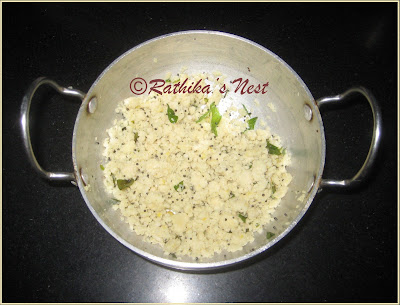Kozhukattai (கொழுக்கட்டை) is a special delicacy made on ‘Vinayaka chathurthi’ (விநாயக சதுர்த்தி) day, though some make it on other auspicious days as well. It is nothing
but rice flour dumpling made with different types of fillings. Traditionally, kozhukattai
is prepared in a rather elaborate method. However, nowadays with the
availability of ready-to-use rice flour, the preparation of this snack has
become simpler. Kozhukattai can be made with fillings such as sweet coconut mix
(தேங்காய் பூரணம்), spicy urad dhal
paste (உளுத்தம் பூரணம்), sesame seeds mix (எள் பூரணம்) and sweet dhal mix (பருப்பு பூரணம்). Of these, most popular ones are sweet coconut and spicy urad dhal
fillings. Kozhukattai is a tasty and rich snack. Following recipe works well
for me. Why don’t you give it a try?
Ingredients:
For
the covering: (makes approximately 20 kozhukattais)
Raw rice flour – 1½ teacup*
Water – 1¾ cup
Gingelly oil – 1 tablespoon
Salt – ¾ teaspoon (adjust to taste)
Gingelly oil – for making the coverings
*Buy any brand of kozhukattai flour
available in the shops.
For the
sweet coconut filling:
Coconut – white meat of half coconut,
grated
Jaggery – ½ teacup or 100ml measure (adjust to taste)
Cardamom – 3 no
Water – ¼ teacup or 50ml measure
For
the spicy dhal filling:
Black gram dhal or urad dhal – ¼ teacup or 50ml measure
Bengal gram dhal or channa dhal – 1
teaspoon
Green chilies – 1-2 no (adjust to taste)
Salt – to taste
Cooking oil – 1 tablespoon
Mustard seeds – ½ teaspoon
Curry leaves – a few
Asafoetida – a generous pinch
How
to prepare sweet coconut filling: Grate the white
meat of coconut finely. Alternatively, you may cut the white meat into smaller
pieces and grind in the mixer using the whipper option. Remove cardamom
seeds and powder them finely. Keep aside.
Heat powdered jaggery with ¼ teacup (50ml) of water in a kadai. Stir occasionally till jaggery
is dissolved fully. Switch off the stove and filter through a sieve to remove
impurities. Now heat the filtered jaggery solution in the kadai and bring it to
boil. Add the grated coconut and cardamom powder. Mix well and cook on low
flame till the water is fully absorbed and the contents start to separate from
the sides of the kadai (Fig.1). Switch off the stove and allow it to cool.
 |
| Fig.1: Sweet coconut filling (தேங்காய் பூரணம்) |
How
to make spicy dhal filling: Wash and soak urad dhal
and channa dhal in sufficient water 2 hours. Later drain the water, wash once
again and drain fully. Grind the dhal with green chillies, salt and asafoetida
into a coarse paste. Steam the paste for 10 minutes in a pressure cooker or a
kitchen steamer.
 |
| Fig.2: Steamed urad dhal paste |
Let it cool and later, crumble it with your hands. Heat oil in
a kadai, add mustard seeds and when they start to sputter, add the crumbled
dhal paste. Saute for 2-3 minutes on low flame. Garnish with curry leaves (Fig.3). Keep
aside.
 |
| Fig.3: Spicy urad dhal filling (உளுத்தம் பூரணம்) |
How
to prepare the kozhukattai covering – Traditional method: Wash and soak raw rice for 4-5 hours. Drain fully, spread on a
clean cloth and dry in the shade overnight. Next morning finely powder the rice
using the mixer-grinder. Pass through a fine sieve to remove any larger
particles. Traditionally, this freshly made flour is used for making
kozhukattai.
Short-cut
method: You may use the ‘kozhukattai’ flour available
in the market. Mix rice flour and salt with the specified quantity of water to form
a thick paste. Add in gingelly oil and mix well.
 |
| Fig.4: Rice flour mixture |
Heat this mixture on medium
flame stirring continuously till the paste thickens and separates from the
sides (Fig.5). Switch off the fire. Cover and keep aside.
 |
| Fig.5: Cooked rice paste |
Note: While making kozhukattai, always keep the remaining flour paste
covered, lest it will dry up and you will find it difficult to spread the
paste.
How
to make kozhukattai: Smear your palms with gingelly
oil. Take a lemon sized ball of rice paste and flatten it into a circle of
around 4” diameter. Place a large gooseberry sized ball of coconut filling in
the center (Fig.6).
 |
| Fig.6: Coconut filling placed in the center of the flattened rice paste |
Bring the edges of the covering on top of the coconut filling and
press the edges together. You may use a kozhukattai mould to shape the
kozhukattai (Fig.7). Repeat the process till the coconut filling is fully used up.
 |
| Fig.7: Use a mould to shape sweet kozhukattai |
Take a large lemon sized ball of rice paste
and flatten it into a circle of around 5” diameter. Place 2 teaspoons of dhal
filling on one half of the circle. Bring the other half over to cover the
filling and seal the edges by pressing them together. Use a different mould such
as ‘somas mould’ to shape kozhukattai (Fig.8). This way you would be able to differentiate sweet and
spicy varieties after steaming. Repeat the process till you use up both rice
flour paste and spicy dhal filling.
 |
| Fig.8: Use 'somas' mould to shape spicy kozhukattai |
Smear oil on steaming trays of either idly
or idiappam mould; arrange the kozhukattais on the trays (Fig.9).
 |
| Fig.9: Kozhukattais ready for steaming |
Steam for 7-10
minutes using a pressure cooker or idly cooker. Switch off the stove, remove from the cooker and serve hot.
If you like this
post, please share it with your friends, followers or contacts, by just
clicking the 'Face book', 'Twitter', ‘Pinterest’ or 'Google +’ icons you see
below the post. Feel free to post your comment/ feedback. Your support is
greatly appreciated. Thank you!

No comments:
Post a Comment